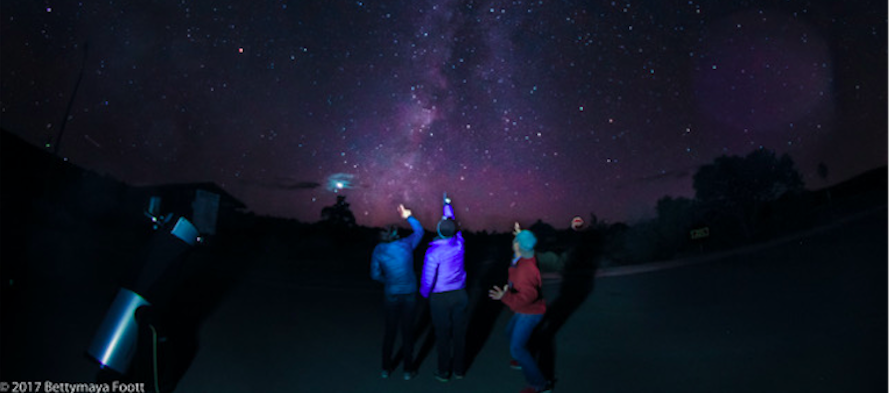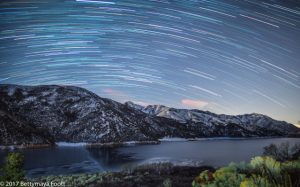
By: Colter Dye, Sustainability Ambassador.
Bridging the borders of three great North American ecosystems: the Great Basin, the Colorado Plateau, and the Rocky Mountains, Salt Lake City is a popular destination for wildlife enthusiasts, outdoor adventurers, and those seeking to connect to the natural world. While snow-capped mountain peaks, vast red deserts, and tree-filled canyons are majestic, one of the most awe-inspiring views comes from glimpsing an arm of the Milky Way Galaxy against a deep blue night sky.
Maintaining a view of our dark skies has implications beyond the inspirational connection to the universe, it is also vital to the health and safety of humans and wildlife as well as our respective ecosystems, which often overlap. The new Consortium for Dark Sky Studies at the University of Utah hopes to preserve access to dark skies.
Formal recognition of the Consortium for Dark Sky Studies (CDSS) was made official last month by the University of Utah, a strategic location for the CDSS as Salt Lake City is central to what Stephen Goldsmith, co-director of the CDSS and associate professor of city and metropolitan planning calls the “Great Starry Way.”
“This portion of the West, basically Montana down to New Mexico, is what I would call the Great Starry Way. These are the darkest places left in the developed world – That’s on the planet, on the Earth!” remarked Goldsmith.

Many migratory birds, including thrushes, wrens, orioles, black birds, cuckoos, tanagers, and most species of sparrow, make the majority of their seasonal migrations during the nighttime hours. Species may migrate during the nighttime hours to avoid daytime predators, maximize foraging time during the day, navigate using the moon or constellations, or to prevent their bodies from overheating due to hours of wing flapping. These species now have to navigate new challenges in nighttime migration caused by the constant blaring lights emitted from human settlements.
Flocks of birds may mistake these glowing metropoles for the shining light of the moon or they may be unable to see the constellations they use to navigate because they are muted by the glowing artificial lights. Other birds seem to mistake gleaming glass windows for the surface of water reflecting moonlight. The fate of many of these birds ends with disorientation or confusion leading to missed navigational points, exhaustion, or a quick demise as they collide with buildings. Each year, in North America alone, anywhere between 365 million and 1 billion birds die from collisions with buildings.
Migrating birds are not the only wildlife affected. Many species of frogs wait for cues from the night sky and the moon to cue their breeding rituals of croaking and calling to find a mate. Nocturnal insects are fatally attracted to artificial lights, preventing them from breeding naturally and making them vulnerable to nighttime predators. On the warmer coasts of the world, baby sea turtles search for the twinkling lights of the moon and stars being reflected on the ocean, but are instead drawn toward the glowing lights of roads and cities, leading them to a certain death by car, dehydration, or predation.
Humans are also physiologically ruled by the regular pattern of night and day. Exposure to artificial light at night negatively affects the human circadian rhythm which not only affects sleep cycles but also the production of important hormones which regulate vital biological processes. These changes have been linked to depression, obesity, as well as breast and prostate cancers. While most cities have had ordinances in place for many years to regulate noise pollution, very few have paid any attention to the important consequences of light trespass and pollution.
The work of the CDSS will help to fill this gap. CDSS affiliates come from many departments of the University of Utah, as well as community, government, and industry partners. Tracy Aviary is an advisor for the CDSS.
Beginning in April of 2016, Tracy Aviary began implementing a strategic campaign to decrease light pollution in Salt Lake County, Utah, by holding a series of ‘migration moonwatch’ events to educate the public about the impact of light pollution on migrating birds. In 2017, the Aviary will expand the program to include strategic data collection on birds that strike buildings as a result of light pollution in Salt Lake’s urban core. Building off of strategies from other successful dark skies projects such as FLAPand “lights out,” the Aviary developed the Salt Lake Avian Collision Survey (SLACS), a citizen science project where volunteers will walk early morning survey routes during the migration season to search for and collect data on birds that had collided with lighted buildings overnight. Information collected by SLACS will help target photon reduction strategies and build public support for a “lights out for migration” initiative in Salt Lake.
This kind of period of decreased artificial light benefits human communities as well as birds and other wildlife. It reduces the consumption of fossil fuels that are used to power unnecessary lights, potentially saving billions of dollars and reducing pollutant emissions by many tons. It also allows humans living in urban areas to reconnect with the night sky and enjoy the Milky Way, which some people may not have seen for many years and some children may have never seen in their lives. Many communities are even using these lights out periods to host festivals celebrating the night sky, uniting divided populations, and teaching citizens about the wonders of astronomy.
With its placement on the foothills of the Wasatch Mountain Range, University of Utah’s campus is one of the only college campuses in the United States that provides a direct connection to wild, undeveloped land and the opportunity for encounters with the natural world. Our special connection to and awareness of the natural world makes our campus the ideal place to continue research on the values of reducing light pollution and implementing practices to restore dark skies to our campus and Salt Lake City.
Colter Dye is an undergraduate student pursuing a degree in Wildlife Ecology and Conservation through the Bachelor of University Studies program at the University of Utah. He is a Sustainability Ambassador for the Sustainability Office at the University of Utah. He is also a Conservation Science Intern at Tracy Aviary and an affiliate of the Consortium for Dark Sky Studies at the University of Utah.
